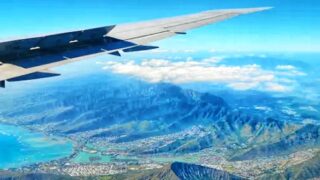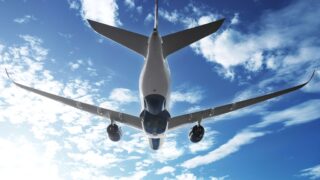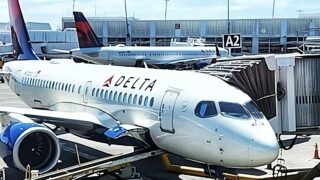Another widebody route to Honolulu is facing turbulent skies as Hawaiian Airlines and Delta Air Lines battle in what appears to be an unsustainable fare war. With one-way prices dropping to just $219 for the grueling 5,095-mile widebody flight, this ridiculously low pricing has left industry experts and travelers questioning the route’s future.
How can either airline sustain such deep discounts on the longest domestic flight in the U.S.? The stakes are high, and the debate over which carrier might be forced to retreat is intensifying.
The unlikely battle over Boston.
Hawaiian Airlines has operated the Boston to Honolulu route using A330 aircraft since its launch in 2019 and is currently flying it four times weekly. The airline has faced challenges in making the route financially viable. That is reflected in regular fares that have dropped to as low as $299 one-way, signaling the struggles Hawaiian has in filling seats.
Delta Air Lines entered the market with seasonal flights running through April 2025, further escalating the competition. By slashing fares to $219 each way, Delta has amplified the pressure on Hawaiian in a way that could make the route unsustainable for either carrier.
Marty, a longtime traveler on the route, shared his concern: “We’ve been flying from Boston to Oahu for years, but if this route disappears, we may finally start exploring other islands. We hope these changes don’t make Hawaii feel less accessible.” For frequent travelers and residents, the stability of this nonstop connection is critical, but the ongoing fare war makes its future uncertain.
Read: Delta vs. Hawaiian: Shake Shack Burgers Fuel New Hawaii Flight Showdown.
Read: Hawaiian Airlines Axes Nonstop Widebody Route As Alaska Takes Control.
Why the Boston to Honolulu route is struggling.
For Hawaiian Airlines, Boston represents both a geographic and strategic outlier. Unlike its West Coast routes, where feeder traffic is far less of an issue, the airline relies almost entirely on point-to-point east coast travelers for the Boston to Honolulu route. Filling seats on such a niche and long-haul route is a challenge without a significant mainland connecting network.
Delta, however, has a distinct advantage. Its extensive domestic and international network enables it to funnel passengers from across the country and even abroad into Boston, providing a solid stream of connecting traffic to its Honolulu flights.
This network gives Delta a competitive edge in sustaining operations, even at bargain prices. While Boston isn’t a full-fledged hub like Atlanta or Minneapolis, Boston is a Delta focus city and plays a vital role in its network.
Kyle S, a frequent flier on this Hawaiian Airlines route, shared his concern: “I’m a frequent flier on the BOS/HNL route. I’d be heartbroken if it gets dropped.” His sentiment reflects the attachment many passengers have to this direct connection. This loyalty, however, may not be enough to overcome the operational and financial pressures intensified by Delta’s aggressive pricing strategy.


Delta’s aggressive strategy.
Delta’s entry into the Boston to Honolulu market is tactical and transitory. The airline announced plans to operate its seasonal A330 widebody service from December 2024 through April 2025, but its aggressive pricing suggests perhaps broader goals of disrupting Hawaiian Airlines’ grip on the route. By undercutting fares, Delta forces Hawaiian to either match unsustainable prices or risk losing passengers entirely.
Dede shared her perspective, saying, “I hope the economics are workable for the Boston to Honolulu route. I greatly prefer the Hawaiian experience to Delta’s in general, but perhaps that will erode as the culture of the merger becomes clearer.”
Her sentiment underscores the challenges Hawaiian faces, not just from Delta’s pricing strategy but also from the uncertainty surrounding its operations post-merger. Delta’s ability to leverage its extensive network further complicates Hawaiian’s position, forcing it to defend a route that may already be on less firm ground.
What this means for travelers.
The current fare war has created incredible deals for travelers. Roundtrip fares at about $400 for such a long-haul flight are virtually unheard of nowadays. However, these prices are unlikely to last, and the route itself may face cuts on one side or the other if profitability isn’t present.
What’s next for this route?
The Boston to Honolulu route encapsulates airlines’ challenges in maintaining widebody Hawaii flights that are popular with travelers. Hawaiian Airlines must weigh the route’s profitability against its strategic value, while Delta appears poised to disrupt without currently committing to offering the route on a long-term permanent basis.
The future of this route is uncertain, but travelers should take advantage of these record-low fares while they last. Whether due to Delta’s seasonal schedule or Hawaiian reevaluating its priorities, the Boston to Honolulu connection may not remain this affordable—or even available—for long.
We welcome your comments!
Get Breaking Hawaii Travel News







Wife and I go Hawaii several times a year to visit family and friends.
We use United as our first choice but Hawaiian now comes close as we fly out of Long Beach to Honolulu as it beats flying out of LAX. Hawaiian flies single aisle aircraft from LB which is not as comfortable.as wide body 787 and 777. I guess price and availability determines which airline we use the most. We hope Hawaiian would use their wide body jets out of Long Beach as that would really make lots of people happy.
My life is complete, I’ve been quoted by Beat of Hawaii! Keep us in the loop guys!
Hi Kyle.
Thank you. You made our day.
Aloha.
I see the United ewr HNL back for March April ’25 , never saw price to be reason to head to JFK and try Hawaiian, would love to try their new 787 thou , but I think that’s outta Boston.
Stories like this make me nuts. No wonder Hawaiian is in financial trouble. If a route is in financial trouble, cut the route! Don’t just keep operating it in hopes things will get better. That’s no way to run a profitable company. Those aircraft are too valuable an asset to be deployed on money-losing routes. If you can’t make the route work financially, look for another route with a better return on investment. This is not rocket science.
To be honest, I welcome Alaska Airlines injecting some financial common sense into Hawaiian Airlines’ operations. I would much rather have Hawaiian Airlines around for the long term, but they must stop making foolish decisions.
United cancelled their EWR HNL 767 non-stop late last year.
EWR Super convenient vs shelp to NY.
Hi Jack.
It’s seasonal still.
Aloha.
Only in theory. I’ve booked it twice in the past couple of years only to have it turn in to a connected flight.
Just out of curiosity, how do the NYC non-stops (HA & DL from JFK and United from EWR Newark) stack up in regard to pricing, load factors, etc for the airlines? I’ve flown HA 50/51 from JFK-HNL multiple times and found the flights enjoyable and reasonably & competitively priced. I find it interesting that there’s but three daily non-stops from this market to HI.
Save a few buck getting there but hotels, new resort tax or user fees will suck up those savings. Airlines always charge extreme prices during Christmas, New Years, Spring Break, and the three months of summer when school kids travel with parents on vacation when school is not in session. 15% non guest restaurant surcharges, green fee’s per person charged at hotels, beach admission pass charge, New pass fees for Diamond Head Park, Hiking trails and such make Hawaii the winner and not the Airlines. With declining tourism the airlines will always sacrifice first.
Hawaiian simply needs to do a better job advertising in the Northeast Corridor because if people don’t know what Hawaiian (Alaskan) has to offer, they’re non the wiser. I have a lot of friends in New England and they’re floored when I tell them that Hawaiian Air had (has) a direct non-stop from BOS>HNL. They only think JetBlue/United will get them to SFO/LAX and then onward. This tells me there’s major room for improvement, since a lot of those friends have unlimited budgets for vacation/travel…
It’s Alaska not Alaskan
Bill, that is so true. I’m a concierge and when I meet guests from Boston, most of them are not aware there is a direct flight from Boston to Honolulu on Hawaiian Airlines!
My prediction, AS will be repositioning all of HA widebodies & deploying them to SEA – Europe routes.
Safe bet, and I’m not not a bettor.
Alaska will never remove all widebodies from HNL. Alaska will probably reposition a some widebodies (787s especially) to Seattle. But it will keep using them where it makes sense from HNL and where they’re the only planes that work (e.g., Japan, Sydney, American Samoa, major West Coast markets like LA, SF, and Seattle). Unprofitable flights like Boston (and other Midwest or east coast domestic routes) are definitely on the chopping block though, especially because Alaska can fly folks via SEA (or PDX, LAX, SFO, or SAN) way more efficiently, something Hawaiian could never do. Plus, if you’re going to a neighbor island from the east coast, I’d rather do two 5-hour flights (connecting on the west coast) than a 9-hour flight to HNL followed by a short hop to Maui, etc. It’s nicer to break up the long journey if you have to have one stop anyway.
Alaska is a well-managed airline, and it’s also not going to torch the profitable parts of Hawaiian’s network.
I don’t think you are correct. The international market from SEA is very competitive with Delta and a lot of foreign carriers operating long haul routes from SEA. Want to fly nonstop from Seattle to London? In summer, there are already 4 daily flights on 3 airlines. Paris? DL and AF already fly it–and Air Tahiti Nui has 2 flights per week now but just announced they are pulling out of the SEA-CDG market in January. SAS will soon restore SEA-CPH, both Lufthansa and Condor fly to FRA, Finnair flies to Helsinki seasonally, etc., etc. The Asian market is just as crowded, with 4 airlines on the SEA-TPE route, 3 on SEA to Tokyo, and 3 on SEA to Seoul.
While it sounds reasonable that AS might want to start long-haul international service from SEA, it would be an extremely risky move. They would either have to enter well-served, competitive markets or pioneer new ones, which probably aren’t served currently for a reason. I’m not holding my breath.
The merger between Alaska and Hawaiian still worries me. Alaska doesn’t seem to have the same commitment to these long-haul Hawaii routes, and I’m afraid we’ll soon lose options.
Honestly, I’m skeptical that either airline is making any money at these fares. At some point, passengers are going to pay the price, either with fewer choices or much higher costs.
Alaska and Hawaiian merging complicates things even more. Will they keep all of these routes, or is Alaska just focused on the West Coast? I’d love to see Atlanta or Miami added. Looks like an interesting time is ahead.
I’ve flown both Delta and Hawaiian from the east coast, and while I prefer Hawaiian’s onboard service, Delta’s network makes it so much easier for me to connect.
Delta’s pricing strategy feels like a short-term play. They’re making it tough for Hawaiian, but I doubt they’re in this for the long haul. What happens when Delta pulls out and Hawaiian can’t keep up?
The nonstop flights to Hawaii have always been such a game-changer for me since I live in Boston area but am from Hawaii. If this fare war leads to one airline dropping out, it’s going to make East Coast travel to Hawaii harder I fear.
Delta will prevail. The large airlines do this all the time. It doesn’t matter if it’s HI or East Overshoe.
I’m not sure why the people commenting for the article would be going to Honolulu multiple times ( unless for work ).
Not sure why you assume travel between these destinations would only be for work. I am retired and have family and friends in both locations, so I spend roughly half the year in each. Even when I was working in Hawaii, I made the trip at least once a year. Loss of a wide-body would make non-stop miserable. Stopping in Seattle wouldn’t be terrible (friends there, too!), but definitely less efficient.
Loss of the A330 route to/from Boston would be a real bummer for me. I am a Hawaii resident with family/friends in Boston. I used to take the United non-stop to/from Newark, but that required an Amtrak link that became too risky during the pandemic. Plus, the wide body and Hawaiian hospitality made the Boston route a relative breeze. Fingers crossed.
HA needs to fly from a long haul hub where they can codeshare / tie in with Alaska’s already existing network and flight schedule to funnel passengers to the widebody flights.
Best Regards
As you stated, Delta has the focus city in Boston and may be able to lose money longer than Alaska can on this route. However, don’t underestimate the hatred that Alaska has for Delta given the battle being waged in Seattle. If Hawaiian had more than 2 787s, I could see those used on the route. This one will be interesting.
@Greg–I don’t know if it’s hatred exactly but DL fully expected to set up a hub in SEA and bring AS to its knees. That didn’t happen because AS is both savvy and competitive. AS has nonstops from SEA to almost anywhere I would want to go in the USA. DL competes on a number of routes but never with as many frequencies unless it’s to another DL hub. You are definitely onto something.